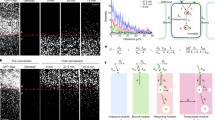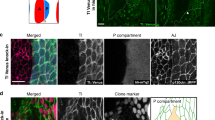Abstract
To be integrated correctly into the developing organism, cells need to interact with an environment that includes neighbouring cells, the extracellular matrix and soluble factors. These interactions probably require specific recognition events mediated by cell-surface molecules, and evidence has accumulated for the presence of such molecules in several organisms (see, for example, refs 1–6). In Drosophila, a family of cell-surface glycoprotein complexes, the position-specific (PS) antigens, may be involved in such processes7–11. PS antigens show spatially restricted distributions on imaginai disks that vary during development; their expression on any particular cell correlates with the position of that cell in the developing disk epithelium rather than with its ultimate differentiation. In contrast to the situation in disks, however, immuno-fluorescence revealed few regional restrictions of PS-antigen expression on other larval tissues7,11. If the PS antigens have a general role in morphogenesis, then widespread regional variation in their distributions might be expected. We now report that, by using polyacrylamide gel electrophoresis (PAGE), a technique that gives higher resolution than immunofluorescence, we detect an increase in both the concentration and the diversity of the complexes during embryogenesis, beginning at gastrulation. Further, each larval and adult tissue examined carries its own characteristic set of complexes. This tissue- and region-specific diversity is achieved by combining different members of a set of related components with a glycoprotein common to all the complexes.
This is a preview of subscription content, access via your institution
Access options
Subscribe to this journal
Receive 51 print issues and online access
$199.00 per year
only $3.90 per issue
Buy this article
- Purchase on Springer Link
- Instant access to full article PDF
Prices may be subject to local taxes which are calculated during checkout
Similar content being viewed by others
References
Kemler, R., Babinet, C., Eisen, H. & Jacob, F. Proc. natn. Acad. Sci. U.S.A. 74, 4449–4452 (1977).
Gerisch, G. in Current Topics in Developmental Biology Vol. 14, Pt 2 (eds Moscona, A. A. & Monroy, A.) 243–269 (Academic, New York, 1980).
Edelman, G. M. Science 219, 450–457 (1983).
Damsky, C. H., Richa, J., Solter, D., Knudsen, K. & Buck, C. A. Cell 34, 455–466 (1983).
Kruse, J. et al. Nature 311, 153–155 (1984).
Rutishauser, U. Nature 310, 549–553 (1984).
Wilcox, M., Brower, D. L. & Smith, R. J. Cell 25, 159–164 (1981).
Brower, D. L., Wilcox, M., Piovant, M., Smith, R. J. & Reger, L. A. Proc. natn. Acad. Sci. U.S.A. 81, 7485–7489 (1984).
Wilcox, M., Brown, N., Piovant, M., Smith, R. J. & White, R. A. H. EMBO J. 3, 2307–2313 (1984).
Brower, D. L. Nature 310, 496–498 (1984).
Brower, D. L., Piovant, M. & Reger, L. A. Devl Biol. 108, 120–130 (1985).
Fullilove, S. L. & Jacobson, A. G. in The Genetics and Biology of Drosophila Vol. 2c (eds Ashburner, M. & Wright, T. R. F.) 105–227 (Academic, New York, 1978).
Hawkes, R. Analyt. Biochem. 123, 143–146 (1982).
Towbin, H., Staehelin, T. & Gordon, J. Proc. natn. Acad. Sci. U.S.A. 76, 4350–4354 (1979).
Cheney, C. M. & Shearn, A. Devl. Biol. 95, 325–330 (1983).
Bonner, W. M. & Laskey, R. A. Eur. J. Biochem. 46, 83–88 (1974).
Author information
Authors and Affiliations
Rights and permissions
About this article
Cite this article
Wilcox, M., Leptin, M. Tissue-specific modulation of a set of related cell surface antigens in Drosophila. Nature 316, 351–354 (1985). https://doi.org/10.1038/316351a0
Received:
Accepted:
Issue Date:
DOI: https://doi.org/10.1038/316351a0
This article is cited by
-
Antibodies recognizing 20-hydroxyecdysone-dependent cell surface antigens during morphogenesis in Drosophila
Roux's Archives of Developmental Biology (1987)
-
Cell biology: The fibronectin receptor family
Nature (1986)
-
Developmental biology: Drosophila proteins pave the way to gene mutations
Nature (1985)
Comments
By submitting a comment you agree to abide by our Terms and Community Guidelines. If you find something abusive or that does not comply with our terms or guidelines please flag it as inappropriate.



